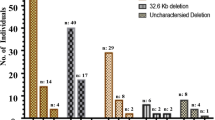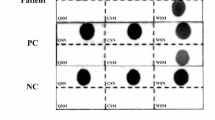Abstract
Copy number variations (CNVs) can cause many genetic disorders and the structure analysis of unknown CNVs is important for clinical diagnosis. The human α-globin gene cluster lies close to the telomere of the short arm on chromosome 16. Copy number variations of this region produce excessive or insufficient α-globin chains which imbalances the β-globin chains, resulting in thalassemia. However, these CNVs usually cannot be precisely defined by traditional methods. Here, we designed a technique strategy and applied it to identify two CNVs involving the α-globin gene cluster causing thalassemia in two Chinese families. A novel 282 kb duplication (αααα282) was identified in family A and a novel 235 kb deletion (--235) in family B. Proband A is a coinheritance of βCD41–42 and αααα282 and showed severe β-thalassemia intermedia phenotype. Proband B is a compound heterozygote of --235/αCSα genotype and was diagnosed with hemoglobin H disease. The clinical phenotypic features of the CNVs carriers were described, together with a complete picture of molecular structure of these rearrangements. Two CNVs are novel rearrangements in α-globin clusters and the αααα282 is the first to identify the exact insert position of a duplication region from the telomere on chromosome 16. In a conclusion, successful identification and characterization of these two novel CNVs not only demonstrates the precision and effectiveness of our strategy in analyzing the structure of unknown CNVs, but also extended the spectrum of thalassemia and provide new examples for studying genomic recombination.





Similar content being viewed by others
References
Blattner A, Brunner-Agten S, Ludin K, Hergersberg M, Herklotz R, Huber AR, Röthlisberger B (2013) Detection of germline rearrangements in patients with α-and β-thalassemia using high resolution array CGH. Blood Cells Mol Dis 51:39–47
Chen XW, Mo QH, Li Q, Zeng R, Xu XM (2007) A novel mutation of -73(A→T) in the CCAAT box of the beta-globin gene identified in a patient with the mild beta-thalassemia intermedia. Ann Hematol 86:653–657
Chen W, Zhang X, Shang X, Cai R, Li L, Zhou T, Sun M, Xiong F, Xu X (2010) The molecular basis of beta-thalassemia intermedia in southern China: genotypic heterogeneity and phenotypic diversity. BMC Med Genet 11:31
Harteveld C, Refaldi C, Cassinerio E, Cappellini M, Giordano P (2008) Segmental duplications involving the α-globin gene cluster are causing β-thalassemia intermedia phenotypes in β-thalassemia heterozygous patients. Blood Cells Mol Dis 40:312–316
Higgs DR (2013) The molecular basis of α-thalassemia. Cold Spring Harbor Perspect Med 3:a011718
Horsley SW, Daniels RJ, Anguita E, Raynham HA, Peden JF, Villegas A, Vickers MA, Green S, Waye JS, Chui D (2001) Monosomy for the most telomeric, gene-rich region of the short arm of human chromosome 16 causes minimal phenotypic effects. Eur J Hum Genet EJHG 9:217–225
Jiang H, Liu S, Zhang, Wan J-H, Li R, Li D-Z (2015) Association of an α-globin gene cluster duplication and heterozygous β-thalassemia in a patient with a severe thalassemia syndrome. Hemoglobin 39:102–106
Joly P, Lacan P, Labalme A, Bonhomme E, Sanlaville D, Francina A (2010) A novel telomeric (~285 kb) α-thalassemia deletion leading to a phenotypically unusual HbH disease. Haematologica 95:850–851
Luo Y, Hermetz KE, Jackson JM, Mulle JG, Dodd A, Tsuchiya KD, Ballif BC, Shaffer LG, Cody JD, Ledbetter DH (2011) Diverse mutational mechanisms cause pathogenic subtelomeric rearrangements. Hum Mol Genet 20:3769–3778
Moosavi SF, Amirian A, Zarbakhsh B, Kordafshari A, Mirzahoseini H, Zeinali S, Karimipoor M (2011) The carrier frequency of α-globin gene triplication in an Iranian population with normal or borderline hematological parameters. Hemoglobin 35:323–330
Origa R, Sollaino MC, Borgna-Pignatti C, Piga A, Feliu TA, Masile V, Galanello R (2014) α-globin gene quadruplication and heterozygous β-thalassemia: a not so rare cause of thalassemia intermedia. Acta Haematol 131:162
Premawardhena A, Fisher CA, Olivieri NF, de Silva S, Sloane-Stanley J, Wood WG, Weatherall DJ (2005) A novel molecular basis for β thalassemia intermedia poses new questions about its pathophysiology. Blood 106:3251–3255
Sollaino MC, Paglietti ME, Perseu L, Giagu N, Loi D, Galanello R (2009) Association of α globin gene quadruplication and heterozygous β thalassemia in patients with thalassemia intermedia. Haematologica 94:1445–1448
Suemasu C, Kimura E, Oliveira D, Bezerra M, Araújo A, Costa F, Sonati M (2011) Characterization of alpha thalassemic genotypes by multiplex ligation-dependent probe amplification in the Brazilian population. Braz J Med Biol Res 44:16–22
Xiao J, Zhang L, Wang J, Jiang Y, Jin L, Lu J, Jin L, Zhong C, Xu X, Zhang F (2014) Rearrangement structure-independent strategy of CNV breakpoint analysis. Mol Genet Genomics 289:755–763
Yu LH, Liu D, Cai R, Shang X, Zhang XH, Ma XX, Yan SH, Fang P, Zheng CG, Wei XF (2015) Changes in hematological parameters in α-thalassemia individuals co-inherited with erythroid Krüppel-like factor mutations. Clin Genet 88:56–61
Zarrei M, MacDonald JR, Merico D, Scherer SW (2015) A copy number variation map of the human genome. Nat Rev Genet 16:172–183
Acknowledgments
This study was supported by grants from the National Natural Science Foundation of China (81200403, 81360091 and U1401221), Science and Technology Program of Guangzhou (201300000095) and the Special Project on the Integration of Industry, Education and Research of Guangdong Province (2012B091000148).
Author information
Authors and Affiliations
Corresponding author
Ethics declarations
Conflict of interest
The authors declare that they have no conflict of interest.
Ethical approval
All procedures performed in studies involving human participants were in accordance with the ethical standards of the institutional research committee and with the 1964 Helsinki declaration and its later amendments or comparable ethical standards.
Informed consent
Informed consent was obtained from all individual participants included in the study.
Additional information
Communicated by Q. Wang.
L. Hu and X. Shang contributed equally to this work.
Rights and permissions
About this article
Cite this article
Hu, L., Shang, X., Yi, S. et al. Two novel copy number variations involving the α-globin gene cluster on chromosome 16 cause thalassemia in two Chinese families. Mol Genet Genomics 291, 1443–1450 (2016). https://doi.org/10.1007/s00438-016-1193-0
Received:
Accepted:
Published:
Issue Date:
DOI: https://doi.org/10.1007/s00438-016-1193-0




